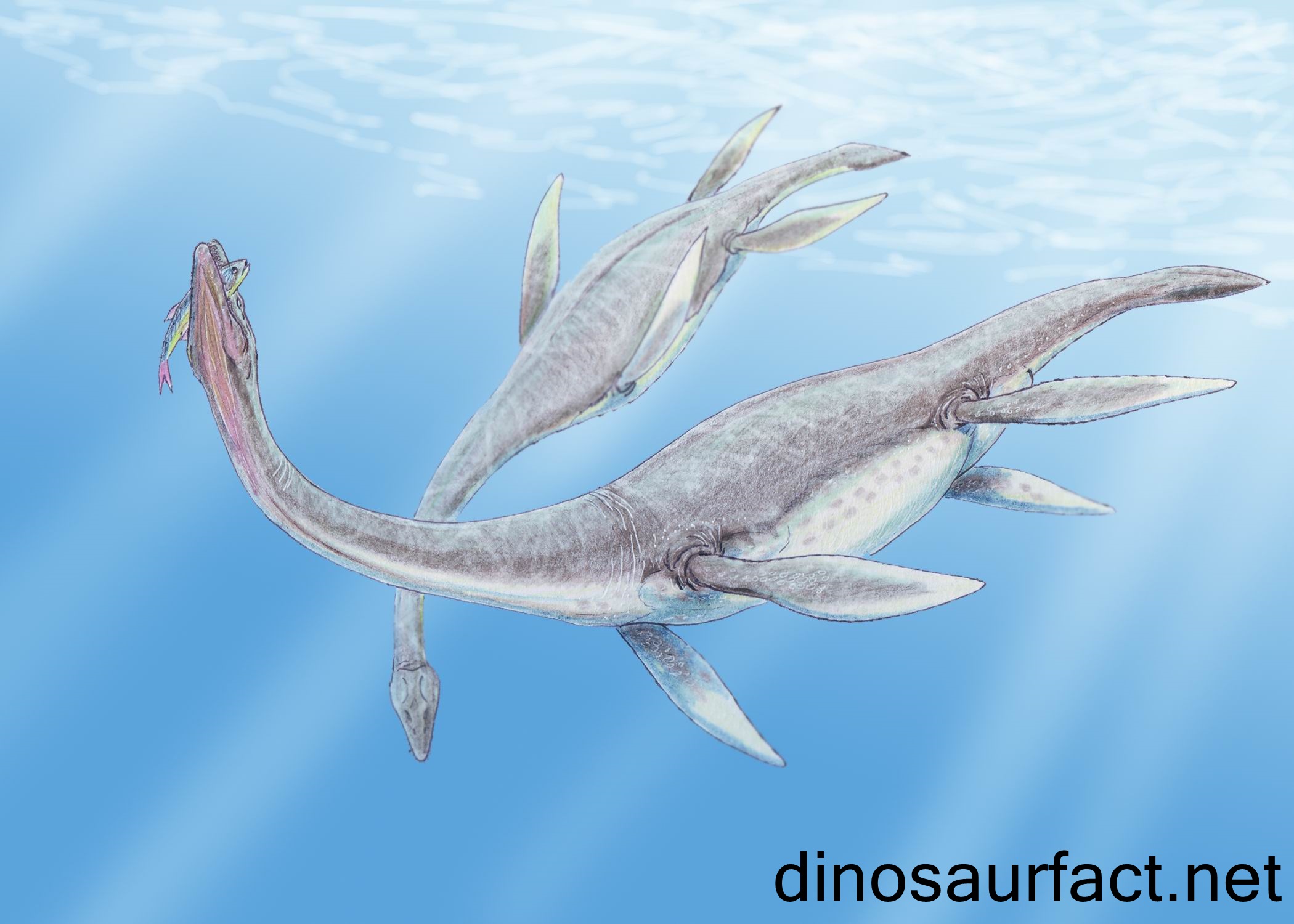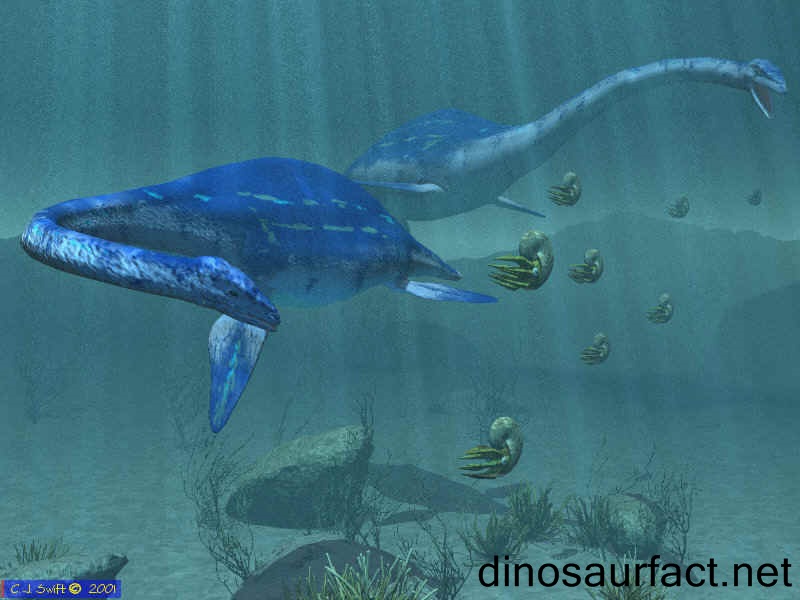 Click to visit the previous Marine Specie bio
Click to visit the previous Marine Specie bio
 |
|
 |
|
Kingdom: Animalia
Phylum: Chordata
Class: Sauropsida
SuperOrder: Sauropterygia
Order: Nothosauroidea
SubOrder: Pachypleurosauria
Family: Pachypleurosauridae
Genus: Dactylosaurus
 |
|
 |
|
 |
|

Dactylosaurus belongs to the genus of Nothosaurus which in turn belong to the family Plachypleurosauridae. Dactylosaurus was accompanied by another sister named Anarosaurus belonging to the Plachypleurosaur clan in early Europe. The name Dactylosaurus is derived from the Greek relevance of daktulos which means finger and saurus refer to lizards. Dactylosaurus had a characteristic nose which were broad and met together. The nasal bones were also characteristically sutured. The cranial study of these fossils suggests that they have large upper temporal fenestrae which are rather kidney shaped. Fossil studies reveal Dactylosaurus have seventeen cervical vertebrae. There also was the presence of characteristic anterior processes in the cervical ribs. There are broad extensions of maxillae by the side of the snout.
It should be noted that Dactylosaurus gracilis closely resembles Neusticosaurus. The ante brachium region of the forelimb is very gracile. From here the species name gracilis is derived. There has been observed a great amount of ossification in the bones of Dactylosaurus when it is compared to other smaller sized Plachypleurosaurs. Detailed fossil studies suggested the presence of a characteristic interzygapophyseal pattern of articulation in the trunk region. The pattern of articulation has been thought to suppress the flexion of the lateral region. As far as evolutionary significance is considered Pachypleurosaurus indicates a distinct radiation Sauropterygians belonging to the Triassic era and also converges certain traits of Plesiosaurus with the emergence of quite a few features belonging to plesiomorphous nature.
Dactylosaurian fossil indicates the presence of these creatures around ten million years ago in Europe. Different fossil discoveries have also hinted that there were more variations in the head region of the different Pachypleurosaurs. Some of the important observations are mentioned in the paragraph that follows.
- The skull of this genus has been observed to have been further evolved into a triangular shape.
- The fossil of the Dactylosaurus skull has a characteristic presence of posterior process which was quite small in size. This posterior process had separated the anterior end of the nasal bone and had been extending up to the posterior portion of the nares.
- The maxillae were broadly extending around the side of the snout. The maxillae reach above the mid-point of the orbit. They end with the nasals resulting in a wide suture.
- The humerus of an adult Dactylosaurus was anything around three and a half centimeters long.
- Fossil study suggested the presence of a distinct delto-pectoral crest. The fossils exhibited clear and distinct articular condyles and an ectepicondyle.
- The character of the humerus was very distinct.
- The number of bones in the hand and the number of bones in the feet were comparatively less in number when compared to other dinosaurs belonging to the same clan.
- The fossils of Dactylosaurus exhibit pterygoid transverse process.
- A characteristic inflation has been observed in the pre frontal region of the Dactylosaurus fossils.
- Fossil studies also indicate a narrow premaxilla.
- The posterior process is generally observed to be comparatively quite short.
- The Dactylosaurus nasals do not reach up to the orbits.
- Inflation is also observed in the post frontal and post orbital region of the skull.
- Fossil studies have shown an abrupt bend in the humerus.
- A remarkable amount of ossification has been observed in the phalanges.
- Phalanges have a characteristic four distal carpals. Among these four carpals three are well ossified.
- A slight amount of inflation has been observed in the dorsal central area. From the lateral angle this region looks like a groove like structure.
- Oppression has been observed in the inner surfaces of the ulna and the radius of the hand. In comparison with the other members of the genus the radius and ulna of Dactylosaurus are not concave in nature.
- The transverse plane is characteristically articulated in this genus. This articulation restricts the lateral bending.
- Pachyostosis is absent in the dorsal ribs of this genus.
- The expansion of the coracoids proximal in the skull is also weak.
- Another characteristic observation of this genus which is worth mentioning is the non-differentiation of the delto pectoral crest region.
- Other features include a rectangular and long inter medium. Ectepicondyle is non distinguishable in Dactylosaurus.
- The radius and ulna are comparatively smaller than Neusticosaurus.
Dactylosaurus is the smallest known pachypleurosaurus discovered till now. As a result Dactylosaurus achieved an adult level of ossification at a much smaller size.
Dactylosaurus was discovered by a noted paleontologist hailing from Germany named Georg Julius Ernst Gurich. Georg Gurich was born in sept 5th 1851. Georg also had a knack for geology. He had several publications. Among them was a notable writing on Geological formations in Poland. Georg was an avid traveler and travelled all around the world namely places like Europe, Venezuela, Australia, Alaska. Later he returned to Africa. Georg was granted the prestigious position of the Director at the Geological Institute of the Hamburg Colonial Institute in the year nineteen hundred and ten. He carried out his research on paleontology Namibia. Professor Georg pursued his education of natural sciences at Wroclaw. He worked as an assistant at the Mineralogical and the Geological Department. In the year eighteen hundred and eighty seven Georg qualified as a professor in the University of Breslau, which is now known as Wroclaw. Professor Georg left for Africa in the year nineteen hundred and fourteen. But unfortunately he was captivated by the British troops during the first world war, subsequently he was released though. He has been known for his work in paleontology especially because of his works on Prussian Silesia. This region is known as the Giant Mountains presently. He also had a precious study on the Paleozoic of Silesia and Poland. He also worked on the Tertiary and Quaternary regions of North Germany. He however had a sense of belonging to Africa. In the later years of his career he hence pursued his work back in Africa. Professor Georg Gurich has been a distinguished author of various geological maps and scientific papers. He sadly passed away on the sixteenth of August in the year nineteen hundred and thirty eight.Index
Extinct Profiles
 Triassic Dinosaurs
Triassic Dinosaurs Jurassic Dinosaurs
Jurassic Dinosaurs Cretaceous Dinosaurs
Cretaceous Dinosaurs Pterosaurs
Pterosaurs Marine Reptiles
Marine Reptiles Dinosaur Extinction
Dinosaur Extinction